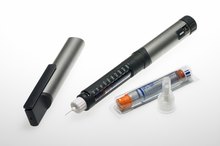Do You Need a Prescription to Buy Diabetic Insulin Syringes?
Diabetics use syringes to self-administer daily insulin injections. Each injection must be given with a new syringe for both safety from infection and for patient comfort. Syringes become dull and contaminated after a single use. A diabetic who uses insulin needs one or more new syringes per day, depending on her injection schedule.
Prescription Requirements
In the United States, prescription requirements for insulin syringes are set by each individual state. Some states require a prescription to buy insulin syringes, some don’t. In some states, notably Florida and Texas, individual counties may impose their own requirements. Laws regarding the purchase of syringes change from time to time, so check with the pharmacy you are planning to use. The pharmacist will know the local laws.
- In the United States, prescription requirements for insulin syringes are set by each individual state.
Types of Syringes
How to Change Refills in Lantus Pens
Learn More
Diabetics use several types of syringes to prepare injections from bottled insulin. The most common is the U-100 insulin syringe. The notation U-100 refers to the number of units of insulin per ml of insulin. Diabetics also use mini pen needles, which are small needles that attach to insulin pens. When the mini pen needle is attached to the insulin pen, it is used to give an injection in the same manner as a traditional syringe. All types are subject to the same prescription laws.
- Diabetics use several types of syringes to prepare injections from bottled insulin.
- When the mini pen needle is attached to the insulin pen, it is used to give an injection in the same manner as a traditional syringe.
Buying Syringes Online
When you buy syringes from an online pharmacy, the pharmacy will abide by the regulations of the state in which it is located. If you live in a state that requires a prescription for syringes and the online pharmacy is located in a state that does not require a prescription, you will be able to buy them without a prescription. Conversely, you will need to provide a prescription for syringes when you are buying from a state that requires them.
Health Insurance Reimbursement
How to Transfer a Prescription From One Pharmacy to Another
Learn More
Even if you can buy syringes without a prescription in your state, you may want to obtain a prescription for them from your physician so you can get reimbursed by your health insurance plan. If you do not have a prescription for the syringes, they will not be covered by your health insurance plan, and you will not be able to buy them at a discounted price negotiated with the pharmacy by your health insurance provider.
Traveling with Syringes
You do not need to carry a prescription with you when you travel by air within the United States. The Transportation Security Administration (TSA) will allow you to take your syringes with you past the security checkpoint after they have been screened. If you do not want your diabetes supplies to be x-rayed, you can request a visual inspection of them. When you are traveling in another country, you may want to carry a prescription for insulin syringes with you because laws vary from country to country.
- You do not need to carry a prescription with you when you travel by air within the United States.
- When you are traveling in another country, you may want to carry a prescription for insulin syringes with you because laws vary from country to country.
Related Articles
References
- Kaiser Permanente. How to store insulin. January 2019.
- Centers for Disease Control and Prevention. Injection drug use and HIV risk. Feb 6, 2020.
- American Diabetes Association. Insulin storage and syringe safety.
- Institute for Safe Medication Practices. Consumer Med Safety Organization. Insulin safety in your home.
Writer Bio
Amy Marie is a software engineer and technical writer who earned a Bachelor of Arts degree in computer science at California State University Long Beach. Her writing appears on eHow and Examiner.com. She specializes in writing about technical, consumer and lifestyle topics.









